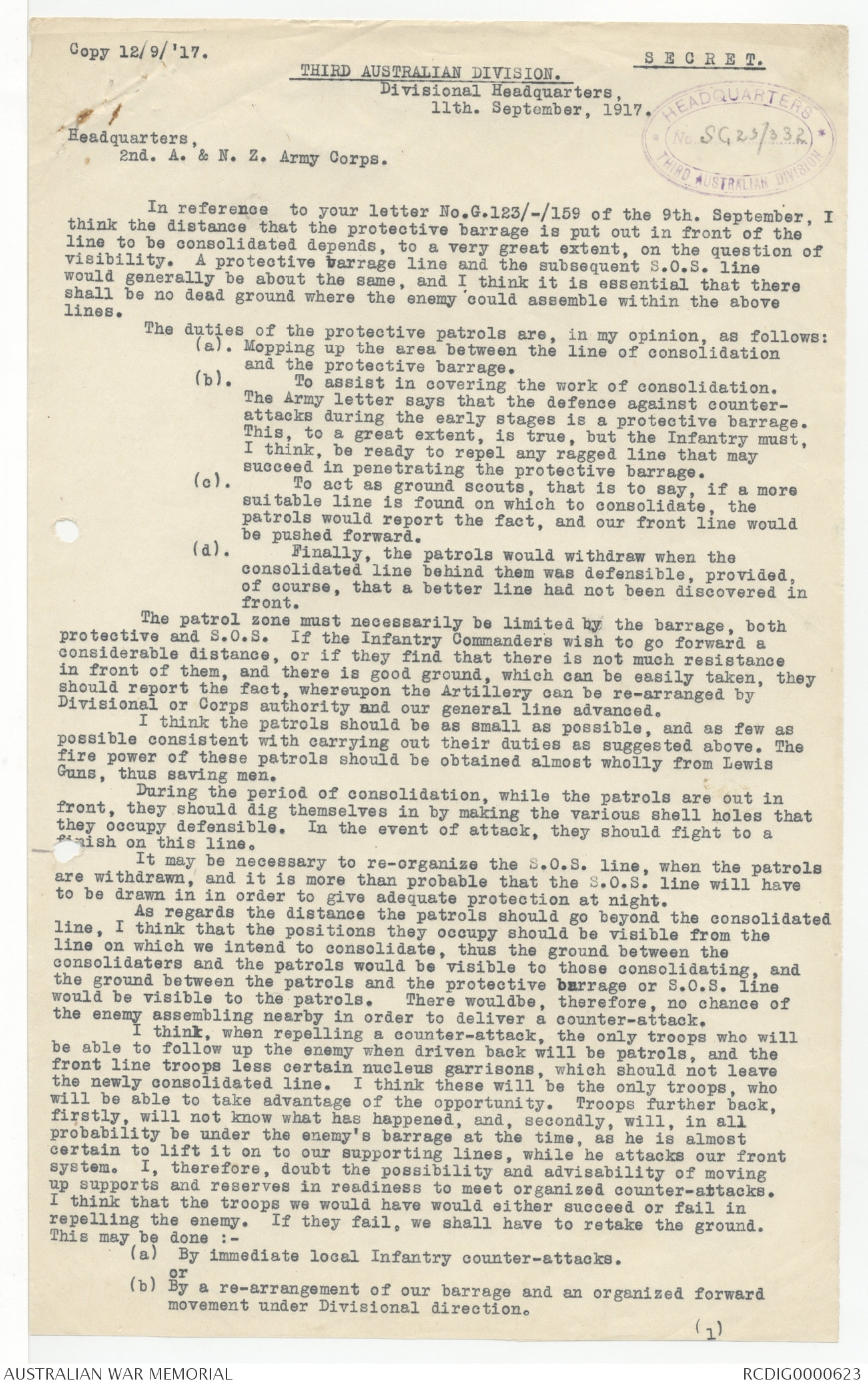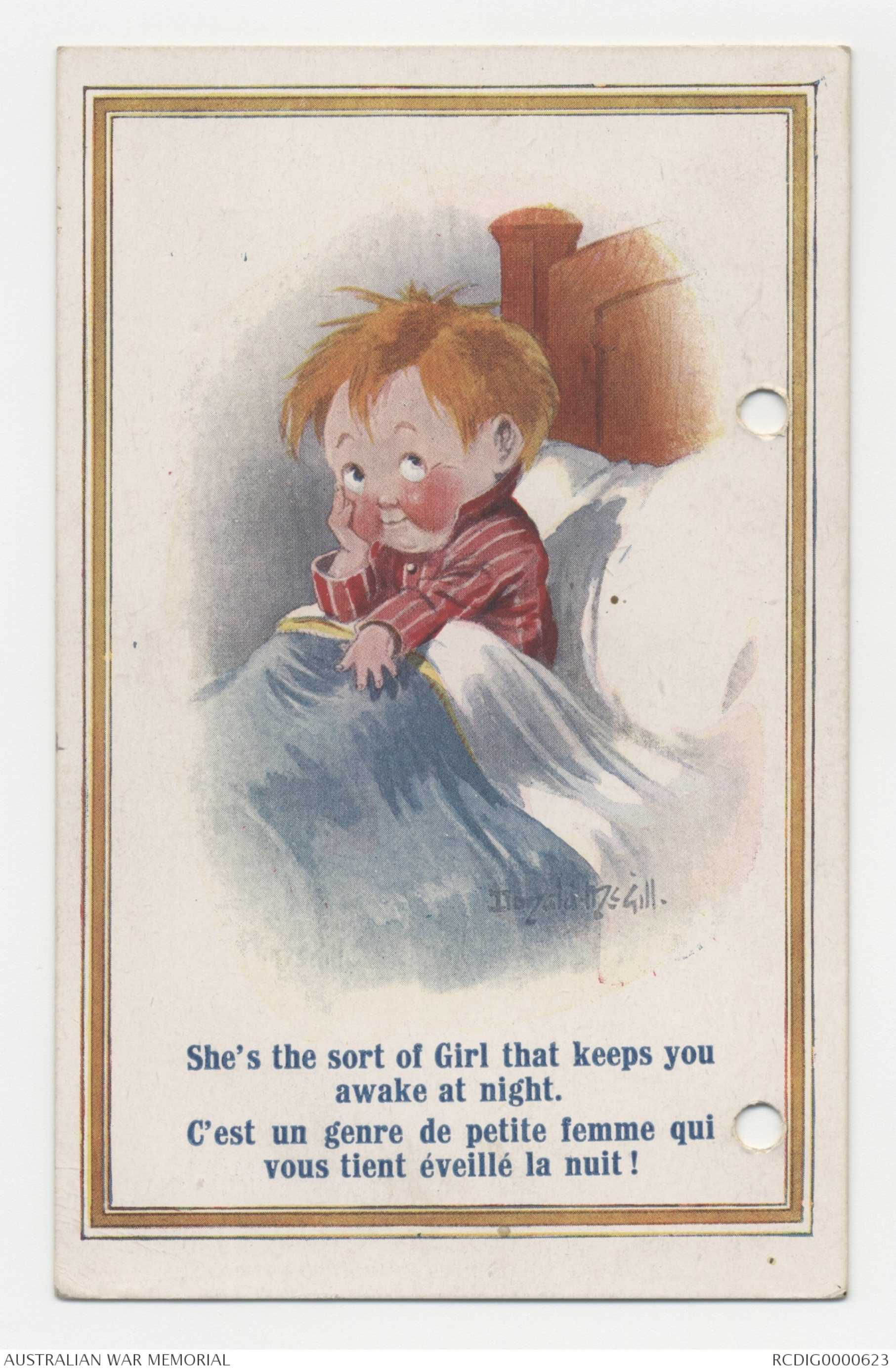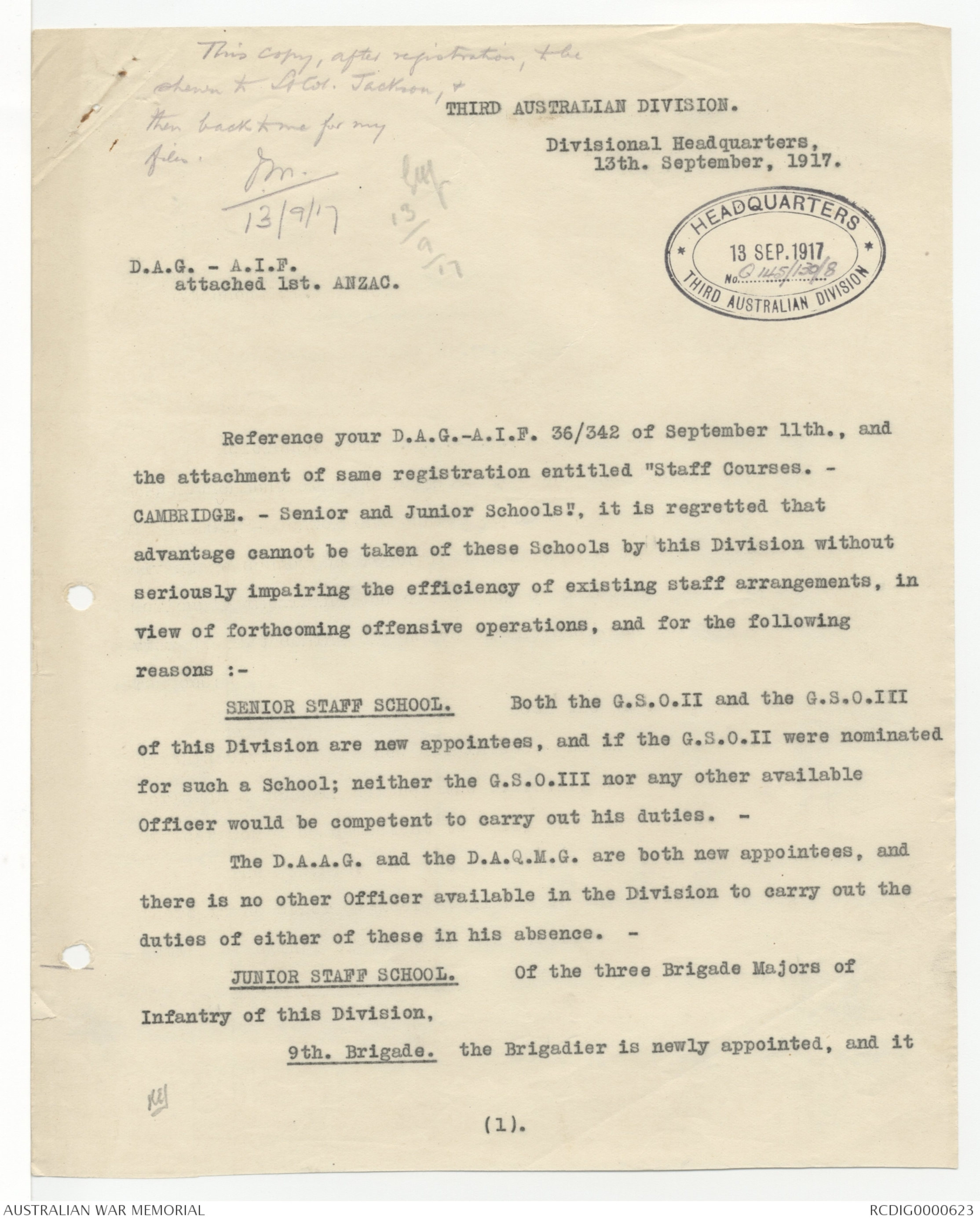Sir John Monash, Personal Files Book 16, 3 September - 9 October 1917, Part 3










GOC.
[*HEADQUARTERS
23 OCT 1917
No. SG25/332
THIRD AUSTRALIAN DIVISION*]
Not to be taken beyond Brigade Headquarters.
SECRET.
SECOND ARMY.
Further Notes on Training and Preparation
for Offensive Operations.
In continuation of “Notes on Training for Offensive Operations" issued by Second Army,
the Army Commander directs that special attention be given to the following points:-
Disposition in Depth both for Attack and Defence.
It must be explained to all ranks why depth of formation is essential and what it means
and what it involves.
In the task before us we shall encounter opposition in depth from the enemy, from defensive
positions in shell-holes, strong points, etc. and from counter-attacks gradually increasing in
strength as we advance, and to deal with these our plan is to have sufficient men and allow
ample time to clear each area included in our advances, and successive bodies of fresh troops
as supports and reserves well forward to meet the counter-attacks.
To be able to carry out this plan successfully, every commander of supporting troops must
know the position and situation of the troops which he is supporting and must utilise every
means at his disposal to do this.
It must be explained to all front line troops that supporting troops are behind them and
getting gradually nearer, so as to assist them at once to destroy any enemy counter-attacks if
necessary, and not only officers but N.CO's. and private soldiers must be kept informed of the
situation.
So long as formations are kept intelligently in depth and men realise the superior power
which their rifles and machine guns give them against enemy counter-attacks, they are in a
position to inflict far-reaching destruction on the enemy.
They should understand that there is no danger if there are "gaps" in the lne or if troops
on their flanks are tempararily checked. The supporting troops will quickly remedy this
provided every unit, however small, clings tenaciously to every point they have gained until
their arrival.
Although troops following a barrage have to move slowly they must be trained to act
quickly when occasion arises.
Troops for the initial stage, i.e., the capture of the First Objective, should be lightly
equipped, and careful training and practice is necessary to ensure that all attacking troops get
started inside the enemy barrage.
Similarly when enemy "strong points" are encountered, these must be dealt with at once
and without hesitation. Delay may be fatal.
“Consolidation” should always be in depth.
10th September, 19117.
C. H. HARINGTON, Major-General,
General Staff, Second Army.
F S C.O.-1314-2000-20-10-17.
Copy 12/9/'17.
SECRET.
THIRD AUSTRALIAN DIVISION.
Divisional Headquarters,
11th. September, 1917.
[*Headquarters,
HEADQUARTERS
No. SG23/332
THIRD AUSTRALIAN DIVISION*]
2nd. A. & N. Z. Army Corps.
In reference to your letter No.G.123/-/159 of the 9th. September, I
think the distance that the protective barrage is put out in front of the
line to be consolidated depends, to a very great extent, on the question of
visibility. A protective barrage line and the subsequent S.O.S. line
would generally be about the same, and I think it is essential that there
shall be no dead ground where the enemy could assemble within the above
lines.
The duties of the protective patrols are, in my opinion, as follows:
(a). Mopping up the area between the line of consolidation
and the protective barrage.
(b). To assist in covering the work of consolidation.
The Army letter says that the defence against counter-attacks
during the early stages is a protective barrage.
This, to a great extent, is true, but the Infantry must,
I think, be ready to repel any ragged line that may
succeed in penetrating the protective barrage.
(c). To act as ground scouts, that is to say, if a more
suitable line is found on which to consolidate, the
patrols would report the fact, and our front line would
be pushed forward.
(d). Finally, the patrols would withdraw when the
consolidated line behind them was defensible, provided,
of course, that a better line had not been discovered in
front.
The patrol zone must necessarily be limited by the barrage, both
protective and S.O.S. If the Infantry Commanders wish to go forward a
considerable distance, or if they find that there is not much resistance
in front of them, and there is good ground, which can be easily taken, they
should report the fact, whereupon the Artillery can be re-arranged by
Divisional or Corps authority and our general line advanced.
I think the patrols should be as small as possible, and as few as
possible consistent with carrying out their duties as suggested above. The
fire power of these patrols should be obtained almost wholly from Lewis
Guns, thus saving men.
During the period of consolidation, while the patrols are out in
front, they should dig themselves in by making the various shell holes that
they occupy defensible. In the event of attack, they should fight to a
finish on this line.
It may be necessary to re-organize the S.O.S. line, when the patrols
are withdrawn, and it is more than probable that the S.O.S. line will have
to be drawn in in order to give adequate protection at night.
As regards the distance the patrols should go beyond the consolidated
line, I think that the positions they occupy should be visible from the
line on which we intend to consolidate, thus the ground between the
consolidaters and the patrols would be visible to those consolidating, and
the ground between the patrols and the protective barrage or S.O.S. line
would be visible to the patrols. There wouldbe, therefore, no chance of
the enemy assembling nearby in order to deliver a counter-attack.
think, when repelling a counter-attack, the only troops who will
be able to follow up the enemy when driven back will be patrols, and the
front line troops less certain nucleus garrisons, which should not leave
the newly consolidated line. I think these will be the only troops, who
will be able to take advantage of the opportunity. Troops further back,
firstly, will not know what has happened, and, secondly, will, in all
probability be under the enemy's barrage at the time, as he is almost
certain to lift it on to our supporting lines, while he attacks our front
system. I therefore, doubt the possibility and advisability of moving
up supports and reserves in readiness to meet organized counter-attacks.
I think that the troops we would have would either succeed or fail in
repelling the enemy. If they fail, we shall have to retake the ground.
This may be done:
(a) By immediate local Infantry counter-attacks.
(b) By a re-arrangement of our barrage and an organized forward
movement under Divisional direction.
(1)
11/9/17.
-2-
I deprecate the idea of having considerable numbers of men exposed
to shell fire, and subjected to considerable strain merely acting as supports
end reserves to repel possible counter-attacks. I think the policy is
uneconomical.
I would, however, advocate the digging of two lines about 200 yards
apart, so that the enemy could not barrage both at the same time with the
same lot of guns. It has been found from experience that one of these lines
or portions of both are soon made defensible. It gives the enemy two lines
to shell, and he is unaware which we intend to hold.
The defence would, therefore, depend
(a) during the period of the protective barrage on the
action of that barrage, the action of the patrols and our
leading waves a portion of whom would be engaged in
digging two distinct lines.
(b) after the protective barrage had died down the
defence would depend on the S.O.S. barrage and the first
and second consolidated lines.
I do not think it would be possible in the early stages to arrange
for the Artillery to concentrate their fire on any area. Apart from this,
I am doubtful whether it would be sound to do so in an undeveloped situation.
I think that the S.O.S. signal going up, the normal S.O.S. barrage should
be put down. If, subsequently, it is found that the enemy's main effort
is against a certain portion of the line, and there is nothing doing
elsewhere, then batteries might concentrate but not otherwise.
It has been found that when the enemy have attempted a counter-
attack, and have been held up by our S.O.S. barrage, good results have
been obtained from the following procedure:-
(a). 50% of the guns were left to continue firing on the S.O.S
line and 50% lifted 500 yards further on into the enemy's
territory being gradually brought back by lifts on to the
S.O.S. line. This dealt satisfactorily with the enemy, who
were lying up waiting and being encouraged by their officers
to go through our barrage. Needless to say, it is only
possible when the numbers of guns are considerable, as, with
a weak barrage, the lifting out of 50% would make it inadequate
and the enemy could then penetrate.
(b). An alternative plan would be when it is known that a
counter-attack has been definitely stopped by our barrage to
make the barrage creep rapidly forward at 50 or 100 yard lifts
in order to catch the enemy who might be lying behind it.
This would not be as effective as lifting out 50%, but it would
be the better plan in the event of our being short of guns.
(Sgd) JOHN MONASH.
Major-General.
Commanding Third Australian Division.
[*HEADQUARTERS
11 SEP.1917
56/13.
THIRD AUSTRALIAN DIVISION*]
THIRD AUSTRALIAN DIVISION.
URGENT
Divisional Headquarters, 11 September, 1917.
A.D.0. for G.O.C. √
"G" Staff,
"A.Q."
Lieut-Colonel G.H.N. Jackgon, O.M.G., D.S.0.,
Lieut-Colonel F.L-L. Henley, D.S.0.,
Captain C.A. Pyke,
3rd. Aust. Divisional Ammn' Column.,
3rd. Aust. Divisional Engineers,
3rd. Aust. Divisional Signal Co.,
3rd. Aust. Infantry Brigade,
10th. do.
11th. do.
3rd. Aust. Pioneer Battalion,
3rd. Aust. Divisional Train,
A.D.M.S., D. A.D.V.S.
Camp Commandant
A. P. M. )
D.A.D.O.S. ) for information.
Reference II ANZAC HORSE SHOW.
The Divisional Commander expresses great disappointment at
the representation at this morning's parade of Transport for the
Divisional selection in connection with the forthcoming II Anzac Horse
Show.
It has now been decided to hold another parade at which
the Units mentioned below will parade the turns-out opposite their
names. These turns-out are to be in Show condition. From those
paraded will be selected the Divisional Representatives.
The parade will be held on the triangular piece of ground
about 300 yards West of the "D" is DRIONVILLE at 10:00 a.m. on Thursday
13th. instant.
EVENT 8. l0th. and 11th. Field Companies, 3rd. Divisional Signal Co.,
9th., 10th. and 11th.Aust. Inf. Brigades, Pioneer
Battalion, 9th., l0th. and 11th. Field Ambulances will
each parade one complete turn-out G.S. Limbered Wagon
with Light Draught Horses.
EVENT 9. Each Field Company, Pioneer Battalion, each Field Ambulance,
will parade one G.S. Wagon with pair of Heavy Draught
Horses.
EVENT 10. Each Unit with Pack Animals on their Establishment will
parade 2.
AUS
2
EVENT 12. Each Field Company, Divisional Signal Co., l0th. and 11th.
Aust. Infantry Brigades, Pioneer Battalion, each Field
Ambulance will parade one G.S. Limbered Wagon with pair of
Mules.
EVENT 13. D.A.C. (S.A..A. Section), each Field Company, each Brigade
Headquarters, Pioneer Battalion, will parade one G.S. Wagon
and team of 4 mules.
EVENT 14. 9th. l0th. and l1th. Aust. Inf. Brigades, Pioneer Battalion,
will parade one Field Kitchen.
EVENT 15. Each Field Ambulance will parade one horsed Ambulance.
Equipment for above will be as laid down in II Aczac
instructions already issued.
The following Units will parade the same turns-out as
were paraded to-day, and these will be judged with the above-
mentioned. Although these Units may have been told on the ground
that they would be the representative in that Class, it is desired to
soe them against the remainedor of the Division.
EVENT 8. 9th. Machine Gun Co. turn-out (Driver TEMPLE)
EVENT 9. Divisional Train.
EVENT 12. 33rd. Battalion.
EVENT 14. 35th. Battalion.
ACKNOWLODGE.
CA.Pyke
Captain.
D.A.Q.M.G., Third Australian Division.
(CAP/DD)
Not sent
THIRD AUSTRALIA DIVISION.
Divisional Headquarters,
12th. September, 1917.
GENERAL STAFF CIRCULAR No. 584. G. 30/59.
The Class of Regimental Sergeant Majors and others, now
working under Captain WALLEY, will disperse on the 15th. instant. -
I am anxious that the endeavours that have been thus
made to improve the well-being and inner workings of Battalions shall
not be fruitless. I hope, therefore, that Battalion Commanders will do
their utmost to help Sergeant Majors in their endeavours to make the
interior administration and discipline of our Battalions second to none.
A good Regimental Sergeant Major should be backed up and
helped in every way - a bad one must be removed. Frequent changes are
to be avoided. Therefore N.C.Os should be promoted to this most important
position who are likely to remain and not pass on to become
This should be explained to them before they become Regimental
Sergeant Majors.
A good Ser Regimental Sergeant Major may not require the
breadth of view, the education, or activity of a Company Officer, but
his qualifications under the following headings should be undoubted.
Strength of Character.
Attention to Detail.
Energy.
Accuracy.
Fairness.
Irreproachable Character.
Capacity for command of men.
Capacity as Drill Instructor.
Disciplinarian.
Unless Adjutants and Regimental Sergeant Majors work in
close touch and are both determined to do all that is possible for the
credit of the Battalion and the well-being of the men, good results cannot
be obtained.
Major-General.-
Commanding Third Australian Division.
DISTRIBUTION.
9th. Aust. Inf. Bde. ............. 7.
10th. do. ............. 7.
11th. do. ............. 7.
3rd. Aust. Pioneer Bn. ............. 1.
Table of Dispositions & Frontages 12/9/17
Divisional Frontage 1200 yards
| Number of | Formations | in Line | Frontages | in | yards | Extension bet. men, based on 32 per platoon |
||
| Brigade | Battalion | Company | Platoon | Brigade | Battalion | Company | Platoon | |
| 1 | 2 | 2 | 2 | 1200 | 600 | 300 | 150 | 9.4 |
| " | " | 3 | 2 | 1200 | 200 | 100 | 6.2 | |
| " | " | 3 | 3 | 1200 | 200 | 67 | 4.1 | |
| " | 3 | 2 | 2 | 1200 | 400 | 200 | 100 | 6.2 |
| " | " | 3 | 2 | 1200 | 400 | 67 | 4.1 | |
| " | " | 3 | 3 | 1200 | 400 | 133 | 44 | 2.8 |
| 2 | 2 | 2 | 2 | 600 | 300 | 150 | 75 | 4.7 |
| " | " | 3 | 2 | 600 | 300 | 100 | 50 | 3.1 |
| " | " | 3 | 3 | 600 | 300 | 100 | 33 | 2.0 |
| " | 3 | 2 | 2 | 600 | 100 | 50 | 3.1 | |
| " | " | 3 | 2 | 600 | 200 | 67 | 33 | 2.0 |
| " | " | 3 | 3 | 600 | 200 | 67 | 22 | 1.4 |
G.O.C. Noted &
now returned
12/9/17 GM
She's the sort of Girl that keeps you
awake at night
C'est un genre de petite femme qui
vous tient éveillé la nuit!
Bailleret 13 Septembre 1912 20/8/17
POST CARD
Cher John,
Il y a un petit moment que je
n ai pas eu de vos nouvelles je pense
bien que vous êtes toujours en bonne sante
ainse que moi. Faites mes compliments
au Camp Comandant ainse que ma soeur
qui sous emoye ges meuilleurs baiser
Mes amities sinceres
Maiie
Vareruyes 7th Rue de Lille Baillent
[*This copy, after registration, to be
shown to Lt Col. Jackson, &
then back to me for my
files.
JM
13/9/17*]
GMY 13/9/7/
THIRD AUSTRALIAN DIVISION.
Divisional Headquarters
13th. September, 1917.
[*HEADQUARTERES
13 SEPT.1917
No Q145/130/8
THIRD AUSTRALIAN DIVISION*]
D.A.G. - A.I.F.
attached 1st ANZAC.
Reference your D.A.G.-A.I.F. 36/342 of September 11th., and
the attachment of same registration entitled "Staff Courses. -
CAMBRIDGE. - Senior and Junior Schools.", it is regretted that
advantage cannot be taken of these Schools by this Division without
seriously impairing the efficiency of existing staff arrangements, in
view of forthcoming offensive operations, and for the following
reasons :-
SENIOR STAFF SCHOOL. Both the G.S.O.II and the G.S.O.III
of this Division are new appointees, and if the G.S.O.II were nominated
for such a School; neither the G.S.O. III nor any other available
Officer would be competent to carry out his duties.-
The D.A.A.G. and the D.A.Q.M.G. are both new appointees, and
there is no other Officer available in the Division to carry out the
duties of either of these in his absence. -
JUNIOR STAFF SCHOOL. Of the three Brigade Majors of
Infantry of this Division,
9th. Brigade. the Brigadier is newly appointed, and it
REJ
(1).
 Sam scott
Sam scottThis transcription item is now locked to you for editing. To release the lock either Save your changes or Cancel.
This lock will be automatically released after 60 minutes of inactivity.